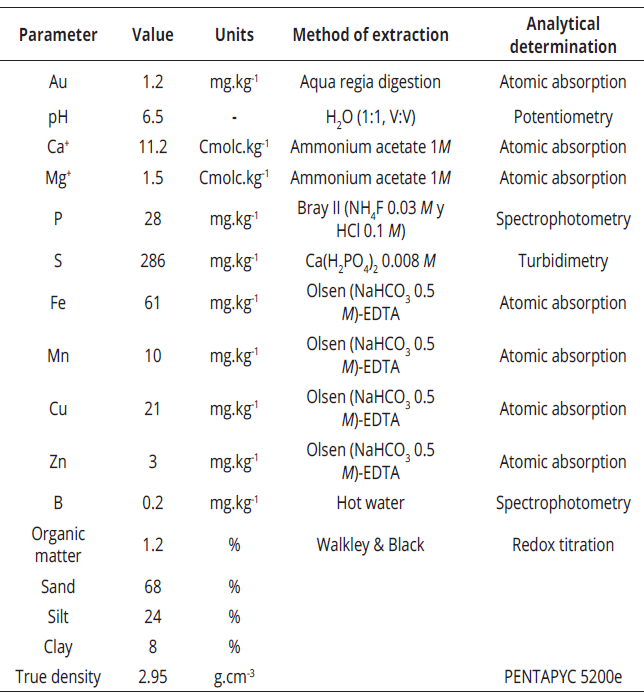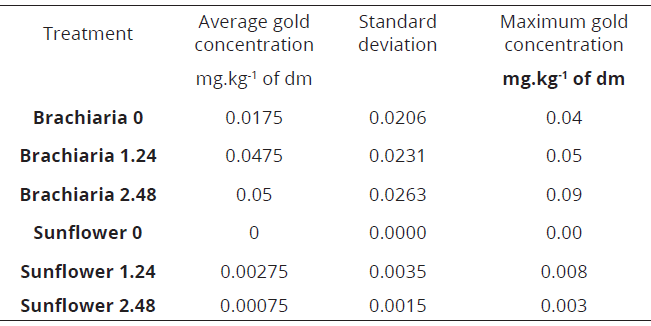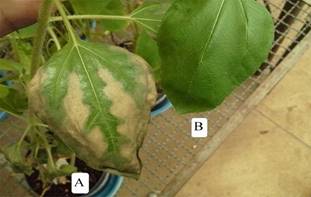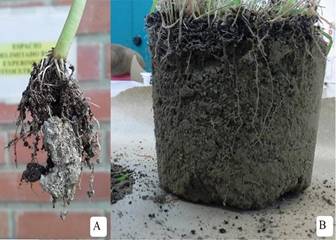Gold phytoextraction and mining-degraded soil reclamation
DOI:
https://doi.org/10.15446/acag.v66n4.59773Palabras clave:
Absorption, aggregates, transpiration, roots (en)Descargas
Gold phytoextraction is a technology used to obtain this metal (Au) throughout plants. Some of the benefits of this technology are the mitigation of the environmental impact, the fact that it does not imply the constant use of pollutants, and has the ability to promote soil reclamation. The aim of this research was to determine if Brachiaria decumbens has the potential to improve soil physical properties while had achieved a gold extraction. For this purpose, Helianthus annuus and Brachiaria decumbens, were used in a completely randomized design with four replicates. To induce gold uptake, ammonium thiocyanate was applied to plants. The statistical analysis was performed using the R-Studio software. Finally, it became evident that B. decumbens is a gold extractor plant, which also improves the soil physical qualities and compared to H. annuus and present higher concentrations of gold than the latter (P<0.05). The dose and mode of application of ammonium thiocyanate, modulates the gold absorption process since it causes toxicity in plants.
Recibido: 27 de agosto de 2016; Aceptado: 9 de marzo de 2017
Abstract
Gold phytoextraction is a technology used to obtain this metal (Au) throughout plants. Some of the benefits of this technology are the mitigation of the environmental impact, the fact that it does not imply the constant use of pollutants, and has the ability to promote soil reclamation. The aim of this research was to determine if Brachiaria decumbens has the potential to improve soil physical properties while had achieved a gold extraction. For this purpose, Helianthus annuus and Brachiaria decumbens, were used in a completely randomized design with four replicates. To induce gold uptake, ammonium thiocyanate was applied to plants. The statistical analysis was performed using the R-Studio software. Finally, it became evident that B. decumbens is a gold extractor plant, which also improves the soil physical qualities and compared to H. annuus and present higher concentrations of gold than the latter (P<0.05). The dose and mode of application of ammonium thiocyanate, modulates the gold absorption process since it causes toxicity in plants.
Keywords:
Absorption, aggregates, transpiration, roots.Resumen
La fitoextracción de oro es una tecnología que consiste en obtener este metal mediante el uso de plantas entre cuyos beneficios está que atenúa el impacto ambiental, no implica el uso constante de contaminantes y favorece la recuperación del suelo. El objetivo de este trabajo fue determinar si la Brachiaria decumbens tiene potencial para mejorar las propiedades físicas del suelo y para, a la vez, extraer oro del mismo. Otro objetivo fue corroborar si Helianthus annuus, además de ser fitoextractora de oro, tiene la capacidad de mejorar las propiedades físicas del suelo. Para esto se emplearon las plantas mencionadas en un diseño completamente aleatorizado con cuatro repeticiones. La absorción de oro fue inducida en las plantas mediante la aplicación de tiocianato de amonio y el análisis estadístico fue realizado usando el software R-Studio. Finalmente, se evidenció que B. decumbens es una planta auroextractora que, además, mejora las propiedades físicas del suelo al igual que H. annuus, presenta mayores concentraciones de oro que esta última (P<0.05). La dosis y la forma de aplicación del tiocianato de amonio modulan el proceso de absorción del oro al generar toxicidad en las plantas.
Palabras clave:
Absorción, agregados, raíces, transpiración.Introduction
Phytoextraction is a technology under development consisting of the utilization of metal-accumulating plants for metal extraction from polluted or metal-rich soils (Chaney et al., 2007). This technique can be an alternative for metal extraction in zones where soil metal concentration is not enough for them to be extracted throughout conventional methods. Phytoextraction is suggested as a possible alternative not only to recover gold, but also nickel (Ni) and thallium (Ti) (Robinson, Bañuelos, Conesa, Evangelou & Schulin, 2009; Wilson-Corral, Anderson, Rodríguez-López, Arenas-Vargas & López-Pérez, 2011).
A hyperaccumulator plant is defined as a plant that accumulates heavy metals in concentrations one hundred times higher than any other plant could accumulate in the same substrate (Anderson, Brooks, Stewart & Simcock, 1998). In order to obtain a considered plant as a gold hyperaccumulator, it must present a concentration of 1mg.kg-1 (Brooks, Chambers, Nicks & Robinson, 1998; Harris, Naidoo, Nokes, Walker, & Orton, 2009).
The major interest in the usage of hyperaccumulator plants is the phytoremediation of contaminated areas by heavy metals. In addition to soil restoration, hyperaccumulation may represent an economic advantage in mining for some highly valuable metals, such as gold (Lamb, Anderson & Haverkamp, 2001). After accumulation, the plants are harvested and ashed to recover target metals. (Kulkarni et al., 2013; Anderson, Moreno & Meech, 2005).
In 1998, Brooks, Chambers, Nicks & Robinson, called phytomining, the technique of using plants with phytoextraction abilities for mining purposes. This technique, consisting in the extraction of precious metals throughout plants, which has been recently studied especially for gold extraction (Anderson, Moreno & Meech, 2005; Girling & Peterson, 1980).
Despite having several reports on hyperaccumulator species, reports on capable plants of accumulating naturally gold do not exist (Harris et al., 2009). According to Lamb et al., 2001, a possible explanation is due to gold is present in the soil in forms in which is impossible to absorb throughout plants. However, Girling & Peterson (1980), reported that plants could actually absorb naturally gold. For instance, they found concentrations of 21.1 ppb of gold in stem samples of Phacelia sericea (Graham) A. Gray, which naturally developed in a substrate and presented a concentration of 1.6 ppb in a mining region in southern British Columbia, Canada.
Gold hyperaccumulation can be promoted by using chemical amendments, which have allowed to be in a form in which the plant can absorb the metal (Wilson-Corral et al., 2011). Among the most used chemical compounds are cyanide (CN-), ammonium thiocyanate (NH4SCN), and ammonium thiosulfate (NH4)2S2O3. These compounds can be metabolized by soil microorganisms and later used as source of carbon, nitrogen and sulfur, according to Ebbs et al., 2010.
Chaney et al. (2007), mention two significant approaches for the development of phytoextraction technology as follows: the domestication of plant hyperaccumulators materials, the cloning of all genes needed for hyperaccumulation and tolerance to insert them and express them in a transgenic hyperaccumulator crop with high-biomass production. Therefore, is necessary an identification of high-metal-accumulator genotypes with fast growth, large potential of biomass production and a great response to nutrients (Bhargava, Carmona, Bhargava & Srivastava, 2012).
In this sense, Harris et al. (2009), mention the current interest in phytomining, which is mainly due to three aspects: a social pressure correlated to the environmental impact of conventional mining, the inability of current mining techniques to recover metals from substrates with low metal concentration in an economically acceptable way and the high cost of these metals in the present tense.
It is known that there are essentially two techniques to recover accumulated metal in soil biomass. The first technique is pyrolysis or combustion, which is followed by ash smelting. This technique is very attractive since the energy released can be used to produce electrical energy. The second technique is the acid digestion of the metal contained in plant biomass throughout electrowinning or solvent extraction to recover the metal (Harris et al., 2009). Other authors as Piccinin et al. (2007), show that phytomining is an economically viable technology. Some aspects to be considered for a successful phytoextraction are mentioned by Wilson-Corral et al. (2011).
Soils affected by mining present high levels of pollution due to a structure loss caused by soil aggregate destruction or the use of pollutants, which additionally affects the soil biota. These soils can be biologically stabilized and recovered throughout plant establishment with dense and deep root systems (Tordoff, Baker & Willis, 2000).
The plant establishment have allowed a soil protection against erosion while retains the soil particles due to an intervention roots to form a "network" that benefits the soil aggregation. This process restores the soil functional and structural attributes to the initial conditions previously to mining activity (Bronick & Lal, 2005). Moreover, a root secretion of exudates, facilitates the presence of fungi and bacteria from the rhizosphere, all of which, produce linking material which benefits flocculation process and soil particles aggregation. In fact, these processes enhance soil physical, chemical and biological properties (Angers & Caron, 1998; Bronick & Lal, 2005).
Due to loss of structure, mining-degraded soils present problems for the establishment of plant populations. This affects the soil porosity and infiltration, which limits the plant growth and root system development (Bengough et al., 2006). When occurs a loss in soil structure, one of the first effects that appears is soil compaction, which inhibits root growth and present a decreasing in water and nutrient uptake ability, which can lead to a poor plant development (Bronick & Lal, 2005).
Conversely, induced changes in soil structure are important due to an improvement in the water storage and its availability to retain soil water (Angers & Caron, 1998). Soil aggregation, promoted by plant establishment, is greater when a high root density and a long root length is present. Therefore, the use of fibrous and extensive roots had achieved a major impact on soil aggregation (Bronick & Lal, 2005).
An inappropriate mining extraction causes a negative impact in the environment and human health due to the use of pollutants in the beneficiation process. Some of those pollutants are mercury (Hg) and cyanide (CN-). In the case of Hg, it accumulates in animals, and provokes air and soil pollution. In fact, mercury is harmful to humans in concentrations in the air as low as 1µg.m-3 (Veiga, 2006).
In Colombia, the usage of mercury reaches amounts up to 150 tons.year-1 (Veiga, 2008), which makes necessary the quest for other alternatives for gold extraction as phytoextraction, since is less risky, and also contributes to soil reclamation.
The aim of this research was to determine if Brachiaria decumbens Stapf and Helianthus annuus L. have the potential to improve soil physical properties while had achieved a gold extraction.
Materials and methods
The research was carried out at Universidad Nacional de Colombia, Medellin campus (UNALMED), in Antioquia, Colombia (6°15'47.07''N-75°34'40.02''O), with an altitude of approximately 1524 m.a.s.l., with an average temperature of 23ºC, an average annual rainfall of 1397 mm and a relative humidity between 66% and 80%.
The substrate used corresponds to a soil sample from two mining zones in the department of Antioquia, Colombia as follows: The municipalities of Gómez Plata and Santa Fe de Antioquia, Colombia. These two soil samples were homogenized and chemically characterized in the Soil Analysis Laboratory of UNALMED, Medellin-Antioquia, Colombia.
The species used were sunflower (H. annuus) and Brachiaria (B. ducumbens), which were sown in containers with 2 kg of substrate, and they were fertilized with 30 g of vermicomposting.
Experimental design for gold phytoextraction
The experimental design corresponded to a completely blocks randomized with six treatments and four replicates, where was carried out a total of twenty-four experimental units as follows: three treatments with sunflower, and the other three with Brachiaria with an addition of ammonium thiocyanate (NH4SCN) to the substrate in doses of 1.24 and 2.48 g kg-1, respectively and a treatment without ammonium thiocyanate addition. Therefore, ammonium thiocyanate was applied in a solution with 100 ml of distilled water in each experimental unit ten days previous to harvest. The experiment was established in fifty-two days.
Gold content determination in plants and substrate
Substrate
The soil sample was analyzed in the Laboratory of Mineralogy Institute CIMEX of UNALMED, Medellin-Antioquia, Colombia. Gold concentration was determined throughout atomic absorption spectrophotometry (device: ICE 3000 SERIES AA, Espectromole Thermoscientific). Gold concentration in soil sample was 1.2 ppm (Table 1).
Table 1: Soil physicochemical characterization used for phytoextraction evaluation

Plants
Ten days after the chemical amendment (NH4SCN) was applied, the twenty-four experimental units were harvested, washed and finally dried in an oven at 105°C until constant weight was reached. The resulting dried material was grinded for subsequent analysis by atomic absorption spectrophotometry, which have allowed the determination of gold concentration in each experimental unity. A general diagram of the procedure carried out for phytoextraction is shown in Figure 1.
Figure 1: Procedure carried out for gold phytoextraction. Substrate homogenization (A). Substrate disposition (B). Application of vermicomposting (C). Phytoextractor plants (D). Grinder (E). Atomic absorption spectrophotometer (F).
Statistical analysis
A Shapiro Wilk test and Bartlett test, were performed to evaluate the data normality and variances homogeneity. Specifically, those data that violated the ANOVA assumptions, a nonparametric test Kruskal-Wallis (α = 0.05), was carried out for gold concentration with a Wilcoxon test (the pairwise.wilcox.test function) without p adjusted (α = 0.05) to identify significant difference among treatments and statistical significance for all comparisons was made at p<0.05. R-Studio software (r) was used to compare the mean values of treatments.
Soil physical properties
A changes evaluation of soil physical properties in the substrate due to the presence of B. ducumbens and H. annus, was performed 45 days after sunflower and brachiaria were sown, respectively. The soil indicators used were as follows: bulk density, measured with a bulk density ring (IGAC, 2004), true density throughout an automatic density analyzer (PENTAPYC 5200e, Quantachrome Instruments, Florida USA), and soil aggregates, which were weighted and the average diameter were measured after wet screening (WADAWS) according to De Lehner & De Boot method, modified by IGAC (2006).
Results
Figure 2: Evidence of toxicity in leaf blade caused by ammonium thiocyanate (NH4SCN). With toxicity (A). Without toxicity (B).
B. decumbens and H. annuus showed the effect of plants in soil structure. In both species, bulk density decreased in 1 g.cm-3, and weighted average diameter after wet screening (WADAWS) increased in an average of 250 µm (Figure 3).
Figure 3: Change in physical variables (Bd = bulk density, WADAWS = weighted average diameter after wet screening) evaluated in the substrate with sunflower (Helianthus annuus L.) and the substrate with Brachiaria grass (Brachiaria decumbens). DAS: days after sowing.
It should be taken into account that this indicates an improvement in soil physical properties due to the action of system root in the soil. In fact, an improvement in the substrate was also evident since the initial substrate had not structure (fine grain) (Figure 1A), compared to the final substrate which presented united particles, which formed a structure (Figure 4).
Figure 4: Evidence of phytostructute in soil generated by the action of sunflower (Helianthus annuus) (A) and (B) Brachiaria grass (Brachiaria decumbens)
Given these concerns, the treatment which presented greatest gold accumulation in dry material was Brachiaria 2.48, which had achieved a concentration of 0.05 mg.kg-1. In the other hand, the treatment with lowest gold accumulation was Sunflower 0, with 0 mg.kg-1. The maximum absorption rate was of 0.09 mg.kg-1 in B2.48, followed by B1.24 with 0.05 mg.kg-1 (Table 2).
Treatments with different concentrations of NH4SCN: Brachiaria 0; 0 g.kg-1; Brachiaria 1.24: 1.24 g.kg-1; Brachiaria 2.48; 2.48 g.kg-1; Sunflower 0;0 g.kg-1; Sunflower 1.24, 1.24 g.kg-1; Sunflower 2.48, 2.48 g.kg-1 of soil. Where dm stands for dry material accordingly to Kruskal-Wallis test (α = 0.05).Table 2: Gold concentration in B. decumbens and sunflower H. annus, under different concentrations of NH4SCN.

Table 3, shows significant differences among treatments. In fact, throughout Wilcoxon test was found that B1.24, was significantly different from treatments with sunflower and B0 g.kg-1, but was not significantly different from B2.48. Despite having a higher mean B2.48 than B1.24, B2.48 was not significantly different from all treatments. This could be due to high dispersions on B2.48 data. A possible explanation for this is based on a plant toxicity, which translates into a quickly death plant (Table 2, Figure 5).
Table 3: Kruskal-Wallis test (α = 0.05).

Same letters: indicates there are not significant differences. Therefore, different letters indicates significant differences. 0, 1.24, 2.48 grams of ammonium thiocyanate per kg of soil.
Discussion
Compared to gold concentration values of 1.64-55.6 mg.kg-1 in sunflower Helianthus annuus L., and 5-76 mg.kg-1 in mustard, Brassica juncea (L.) Czern., reported by Wilson-Corral et al. (2011), and Lamb et al. (2001), gold concentration values obtained in this research were very low, since the highest concentration in this experiment was of 0.09 mg.kg-1 in B. decumbens. This could be due to a strong toxicity in plants treated with NH4SCN, which generated necrosis in the leaf blade (Figure 2).
Nonetheless, it is worth noting that the substrates used in this research, presented a higher gold concentration (2.35 mg.kg-1 and 5 mg.kg-1, respectively), which is according to previously reported by Wilson-Corral et al. (2011), where is considered as one of the factors to be taken into account for a successful gold extraction.
The application form of NH4SCN could have disfavored the physiological mechanisms which have allowed the plant to absorb gold. Conversely, dose applications at different timing or in lower doses, which confirmed the reported data and obtained by Anderson et al. (1998), could increase the plant ability to absorb gold from soil in a more effective way and during a longer period of time due to a lower toxicity, which could lead to a greater metal absorption.
This drawback can be overcome by potential of B. decumbes acting as gold extractor, perhaps related to a genetic condition and due this occurs in high density planting. This type of grass is constituted with a large transpiratory surface compared to sunflower, which have allowed a great movement of gold released on the soil solution throughout xylematic continuum.
Conclusion
Brachiaria decumbens has potential for gold phytoextraction, presenting a maximum extraction value of 0.09 mg.kg-1 of dm, which is higher than 0.008 mg.kg-1 found on sunflower Helianthus annuus L., a species with reported potential for gold phytoextraction. The application of ammonium thiocyanate are thought to contribute and modules the gold absorption process since produces a plant toxicity, which is more evident in the leaf blade death in both species. Alternatively, is believed to be an outcome of hampering transpiration and gold uptake from the substrate. Both species, Brachiaria decumbens Stapf. and Helianthus annuus L., had achieved a soil physical properties improvement with an increasing soil aggregation and soil weighted average diameter after wet screening (WADAWS) with an average of 250 µm. Therefore, both species also contributes to a decreasing soil bulk density (Bd) with an average of 1 g.cm-3.
Acknowledgments
We are grateful to soil physics laboratory at Universidad Nacional de Colombia, Medellin campus (UNALMED), in Antioquia, Colombia. To Luis Fernando Arenas, Maria Catalina Ocampo, and specially, to Rosa Elena Jurado Palacio.
References
Referencias
Anderson, C. W. N., Brooks, R. R., Stewart, R. B. & Simcock, R. (1998). Harvesting a crop of gold in plants. Nature, 395 (6702), 553–554. http://dx.doi.org/10.1038/26875
Anderson, C., Moreno, F. & Meech, J. (2005). A field demonstration of gold phytoextraction technology. Miner Eng, 18(4), 385–392. http://dx.doi.org/0.1016/j.mineng.2004.07.002
Angers, D., & Caron, J. (1998). Plant induced changes in soil structure: Processes and feedbacks. Biogeochemistry, 42, 55–72. http://dx.doi.org/ 10.1007/978-94-017-2691-7_3
Bengough, A.G., Bransby, M.F., Hans, J., Mckenna, S.J., Roberts, T.J. & Valentine, T.A. (2006). Root responses to soil physical conditions, growth dynamics from field to cell. J Exp Bot, 57, 437-447. http://dx.doi.org/10.1093/jxb/erj003
Bhargava, A., Carmona, F. F., Bhargava, M. & Srivastava, S. (2012). Approaches for enhanced phytoextraction of heavy metals. J Environ Manage, 105, 103–120. http://dx.doi.org/10.1016/j.jenvman.2012.04.002
Bronick, C. J., & Lal, R. (2005). Soil structure and management: A review. Geoderma, 124(1-2), 3–22. http://doi.org/10.1016/j.geoderma.2004.03.005
Brooks, R. R., Chambers, M. F., Nicks, L. J. & Robinson, B. H. (1998). Phytomining. Trends Plant Sci, 3 (9), 359–362. http://dx.doi.org/10.1016/S1360-1385(98)01283-7
Chaney, R.L., Angle, J.S., Broadhurst, C.L., Peters, C.A., Tappero, R.V. & Sparks, D.L. (2007). Improved understanding of hyperaccumulation yields commercial phytoextraction and phytomining technologies. J Environ Qual, 36 (5), 1429–1443. http://dx.doi.org/10.2134/jeq2006.0514
Ebbs, S. D., Kolev, S. D., Piccinin, R. C. R., Woodrow, I. E. & Baker, A. J. M. (2010). Solubilization of heavy metals from gold ore by adjuvants used during gold phytomining. Miner Eng, 23(10), 819–822. http://dx.doi.org/ 10.1016/j.mineng.2010.06.002
Girling, C. A. & Peterson, P. J. (1980). Gold in plants. Gold Bulletin, 13 (4), 151–157. http://dx.doi.org/10.1007/BF03215461
IGAC. (2006) Métodos analíticos del laboratorio. 6ta Edición. http://www.igac.gov.co/wps/wcm/connect/dd516280464b0aab8a70cb525e257f7f/LISTADO+DE+METODOS+EMPLEADOS+EN+EL+LABORATORIO+NAC%20IONAL+DE+SUELOS.pdf?MOD=AJPERES
Harris, A. T., Naidoo, K., Nokes, J., Walker, T. & Orton, F. (2009). Indicative assessment of the feasibility of Ni and Au phytomining in Australia. J Clean Prod, 17(2), 194–200. http://doi.org/10.1016/j.jclepro.2008.04.011
Kulkarni, M.G., Stirk, W.A., Southway, C., Papenfus, H.B., Swart, P.A., Lux, A., Vaculík, M., Martinka, M. & Van Staden, J. (2013). Plant growth regulators enhance gold uptake in Brassica juncea. Int J Phytoremediat, 15 (2), 117–126. http://doi.org/10.1080/15226514.2012.683207
Lamb, A. E., Anderson, C. W. N. & Haverkamp, R. G. (2001). The induced accumulation of gold in the plants Brassica juncea, Berkheya coddii and chicory. Chem New Zealand. 2011, 34-36. http://www.massey.ac.nz/~rhaverka/LambCNZ2001b.pdf
Piccinin, R. C. R., Ebbs, S. D., Reichman, S. M., Kolev, S. D., Woodrow, I. E., & Baker, A. J. M. (2007). A screen of some native Australian flora and exotic agricultural species for their potential application in cyanide-induced phytoextraction of gold. Miner Eng, 20(14), 1327–1330. http://doi.org/10.1016/j.mineng.2007.07.005
Robinson, B., Bañuelos, G., Conesa, H., Evangelou, M. & Schulin, R. (2009). The phytomanagement of trace elements in soil. Crit Rev Plant Sci, 28 (4), 240–266. http://doi.org/10.1080/07352680903035424
Tordoff, G.M., Baker, J.M. & Willis, A.J. (2000). Current approaches to the revegetation and reclamation of metalliferous mine wastes. Chemosphere, 41(1-2), 219- 228. https://doi.org/10.1016/S0045-6535 (99)00414-2
Veiga, M.M. (2008). Antioquia, Colombia: the world’s most polluted place by mercury: impressions from two field trips. UNIDO. United Nations Industrial Development Organization. British, Columbia. https://redjusticiaambientalcolombia.files.wordpress.com/2011/05/final_revised_feb_2010_veiga_antioquia_field_trip_report.pdf.
Veiga, M.M., Maxson, P.A. & Hylander, L.D. (2006). Origin and consumption of mercury in small-scale gold mining. J Clean Prod, 14(3-4), 436-447. https://doi.org/10.1016/j.jclepro.2004.08.010
Wilson-Corral, V., Anderson, C., Rodriguez-Lopez, M., Arenas-Vargas, M. & Lopez-Perez, J. (2011). Phytoextraction of gold and copper from mine tailings with Helianthus annuus L. and Kalanchoe serrata L. Miner Eng, 24 (13), 1488–1494. https://doi.org/10.1016/j.mineng.2011.07.014
Cómo citar
APA
ACM
ACS
ABNT
Chicago
Harvard
IEEE
MLA
Turabian
Vancouver
Descargar cita
CrossRef Cited-by
1. Ramiro Ramirez Pisco, Daniela Giraldo Jiménez, Dairo Barrera Cruz. (2018). Fitoextracción de cadmio con hierba mora (Solanum nigrum L.) en suelos cultivados con cacao (Theobroma cacao L.). Acta Agronómica, 67(3), p.420. https://doi.org/10.15446/acag.v67n3.68536.
2. Fariha Nafeesa Md Fadzil, Mohd Azrul Naim Mohamad, Rimi Repin, Zakuan Azizi Shamsul Harumain. (2024). Metal uptake and tolerance in hyperaccumulator plants: Advancing phytomining strategies. Rhizosphere, 29, p.100836. https://doi.org/10.1016/j.rhisph.2023.100836.
Dimensions
PlumX
Visitas a la página del resumen del artículo
Descargas
Licencia
Derechos de autor 2017 Acta Agronómica

Esta obra está bajo una licencia internacional Creative Commons Atribución-NoComercial-SinDerivadas 4.0.
Política sobre Derechos de autor:Los autores que publican en la revista se acogen al código de licencia creative commons 4.0 de atribución, no comercial, sin derivados.
Es decir, que aún siendo la Revista Acta Agronómica de acceso libre, los usuarios pueden descargar la información contenida en ella, pero deben darle atribución o reconocimiento de propiedad intelectual, deben usarlo tal como está, sin derivación alguna y no debe ser usado con fines comerciales.
































